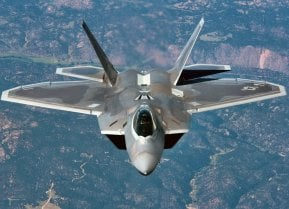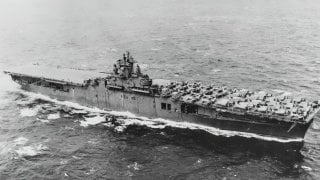USS Lexington: One of the Greatest U.S. Navy Aircraft Carriers Ever
The USS Lexington (CV-16), an Essex-class aircraft carrier, served in major WWII engagements and earned the nickname "The Blue Ghost."
Summary: The USS Lexington (CV-16), an Essex-class aircraft carrier, served in major WWII engagements and earned the nickname "The Blue Ghost."
-Commissioned in 1943, it supported operations in the Pacific, contributing to significant battles like Leyte Gulf.
-Post-WWII, it was modernized for the Cold War and reclassified multiple times before retiring in 1991.
-Now a floating museum in Corpus Christi, Texas, the Lexington honors WWII veterans and has been featured in films and commercials.
Essex-Class (CV-16) USS Lexington: WWII Aircraft Carrier Hero Now a Floating Museum
For more than three decades, the city of Corpus Christi, Texas, has been home to one the longest serving Essex-class aircraft carriers – now preserved as a floating museum, and just one of four World War II carriers remaining. The United State Navy's USS Lexington (CV-16) took part in several major engagements during the Second World War, was modernized and recalled to service during the Cold War – reclassified four times – only finally retired in November 1991.
The final ship of the Essex-class, and the last wooden-deck aircraft carrier to serve with the U.S. Navy, she was laid down at the Fore River Shipyard in Quincy, Massachusetts, on July 15, 1942, and commissioned just 73 weeks later, on February 17, 1943.
Originally designated Cabot, her name was changed to commemorate the recently-lost USS Lexington (CV-2) – sunk at the Battle of the Coral Sea in May 1942. CV-16 was the fifth ship to bear the name honoring the Battle of Lexington, from which the shot was "heard round the world" igniting the American Revolution.
World War II Service
The USS Lexington served as the flagship of Task Force 58, and was present at every major engagement from Tarawa to Tokyo.
As reported by Maya Carlin for The National Interest, "In the Battle of the Philippine Sea and what has come to be referred to as the 'Great Marianas Turkey Shoot,' U.S. naval aviators destroyed over 300 enemy aircraft, one carrier, one tanker, and one destroyer. The loss was catastrophic to the Japanese in that not only were 300 aircraft destroyed, but so too were 300 aviators lost, hindering Japan's aerial capabilities for the rest of the war."
At the Battle of Leyte Gulf, the greatest naval battle of the Second World War and by some accounts the great naval battle in history, the aircraft operating from the carrier were solely responsible for sinking the Imperial Japanese Navy's (IJN's) carrier Zuikako and the cruiser Nachi, while the aircraft shared in the destruction of the IJN's mighty Yamato-class battleship Musashi and the carriers Chitose and Zuiho.
In total, she spent 21 months in combat, during which her aircraft destroyed 372 enemy planes in the air and another 475 on the ground. The carrier sank or destroyed 300,000 tons of enemy cargo and damaged an additional 600,000 tons. Her own guns show 15 Japanese aircraft and assisted in downing five more.
CV-16 was damaged twice during Japanese air attacks, which led the Japanese to report that she was sunk no less than four times. As she always returned to the fight, Japanese propagandist Tokyo Rose nicknamed her "The Blue Ghost," which was soon embraced by the crew and air groups that served on the carrier.
Following Japan's surrender, the carrier's aircraft continued to fly air patrols and even located and took part in supply drops to prisoner-of-war camps on Honsh that had been abandoned by the Japanese. In December 1945, USS Lexington was used to ferry home servicemen during Operation Magic Carpet, and arrived in San Francisco on December 16.
For her World War II service, the USS Lexington received the Presidential Unit Citation for heroism in action, as well as 11 battle stars for major engagements.
That could have been the end of the story.
Returned to Service
In April 1947, CV-16 was placed in the reserve fleet. Call backed to service in September 1953, the USS Lexington was transferred to Puget Sound Navy Yard for major reconstruction, which included reconfiguring her flight deck to incorporate an angled landing area along with steam catapults, provision of an enclosed foredeck, strengthening of the arrester gear, and the enlarging of her forward lift.
She was recommissioned as attack carrier (CVA-16) in August 1955, and rejoined the Pacific Fleet – later redesignated as an anti-submarine carrier (CVS-16). During her "second career," the USS Lexington operated in the Atlantic and Pacific Oceans as well as the Mediterranean. In 1962, she served as part of the naval blockade of Cuba during the "Cuban Missile Crisis."
However, the carrier spent most of her time – nearly 30 years in total – on the East Coast as training carrier (CVT) until her decommissioning in late 1991, and was transferred to Corpus Christi, Texas, where she remains a floating museum, honoring the Greatest Generation.
A Pop Culture Platform
Beyond being maintained as a museum, the USS Lexington was employed as a film location at sea for the 1976 film Midway, standing in for the USS Midway (CV-5); and latter for the 1988 mini-series War and Remembrance, standing in for USS Enterprise (CV-6).
She was also used in the filming of the Michael Bay 2001 epic Pearl Harbor, where she was altered to serve as a Japanese carrier but also the USS Hornet (CV-8). In 2014, the decommissioned USS Lexington was used by Pepsi for a commercial in advance of the 2015 Super Bowl. Titled " Operation Halftime," the ad featured country-music singer Blake Shelton performing for veterans and their families.
Author Experience and Expertise: Peter Suciu
Peter Suciu is a Michigan-based writer. He has contributed to more than four dozen magazines, newspapers, and websites with over 3,200 published pieces over a twenty-year career in journalism. He regularly writes about military hardware, firearms history, cybersecurity, politics, and international affairs. Peter is also a Contributing Writer for Forbes and Clearance Jobs. You can follow him on Twitter: @PeterSuciu. You can email the author: [email protected].
Image Credit: Creative Commons.


